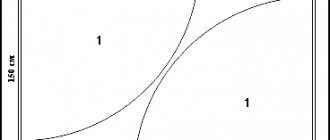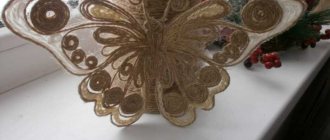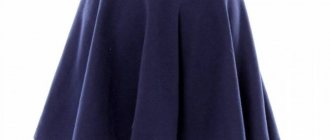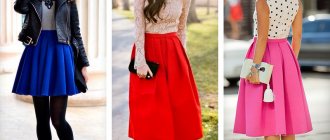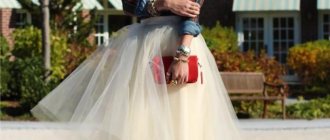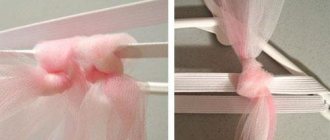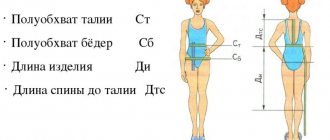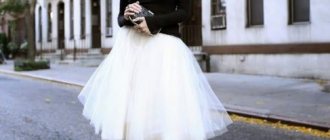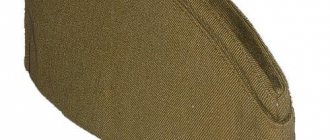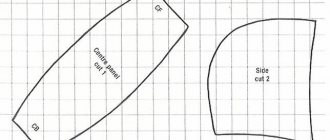Often in life there are spontaneous desires to do something with your own hands. Surely many girls have thought about sewing, because it is convenient and profitable.
There are two ways to realize your idea: take a sewing course or learn it yourself at home. It's better to start with simple things that don't require much experience. This article will help you learn how to sew a skirt with your own hands.
Necessary materials
To sew a skirt you will need the following materials:
- fabric (at your discretion);
- needles and threads;
- scissors and centimeter;
- paper for pattern.
Having this set, you can safely get to work. As an addition, you can purchase various decorative elements.
Sewing technology
An important step is stitching the skirt parts, which occurs in stages:
Straight skirt sewing technology
- First, you need to carefully process the side cuts and seam cuts in the middle of the back using an overlocker.
- Then you need to stitch the darts on the front and back panels. After which they need to be properly ironed towards the middle.
- After this, you need to machine the back seam to the mark for sewing in the hidden zipper.
- The next step is sewing in the zipper.
- Then the side sections are connected with a seam, the width of which is 1 centimeter. After that, bartacks are placed at the end and at the beginning of the lines.
- At the next stage, it is necessary to process the lower part of the product into a hem. The hem allowance is from 3 to 5 centimeters. First you need to tuck the fabric one and a half centimeters, then another two. Then you need to stitch the product as close as possible to the height of the hem. The hem can be sewn by hand, or it can be made using adhesive tape.
- Finally, you need to sew the belt to the skirt.
Technology for sewing a straight skirt
The choice of fabrics for a straight skirt is huge. You can use suit material, or thick knitwear. Even “noodles” are suitable for sewing a skirt. However, in the case of the latter fabric, some nuances need to be taken into account. For beginners, the first two options are suitable. It is better to choose materials - natural fabrics. Since a large number of synthetic fibers significantly reduces the cost of the appearance of the finished product.
Manufacturing begins with taking measurements. Then you need to transfer the indicators onto special paper, make a drawing and cut it out. Then you need to cut out the details of the future wardrobe item. The final stage is sewing. For more experienced craftswomen, a model with a wrap or half-sun will be of interest, which has not lost its relevance over the past few seasons.
A straight silhouette skirt is an essential item in any woman’s wardrobe along with a midi skirt. It will not only complement the image, but will also favorably emphasize the advantages of the figure of the fairer sex. The skirt can be purchased at the store, or you can make it yourself. To do this, just use the simplest pattern for beginners.
Constructing a pattern
In the atelier, experienced tailors do not use patterns for each model. Their experience will allow you to cope without additional tools. If you are taking up sewing for the first time, then purchase special paper for patterns; it will help you cut out the correct parts for the product accurately and without flaws.
You don’t have to make a skirt pattern for sewing with your own hands every time. It is enough to make one, adjusting it to the parameters of the figure. It can be used constantly, sometimes supplemented with various details.
It’s rare to make a pattern perfectly the first time. Therefore, it is recommended to leave seam allowances of at least 2 centimeters.
So, to build a drawing, you need to take 3 measurements:
- waist circumference;
- circumference of the widest part of the hips;
- length of the finished product.
If you want to do everything the first time and without mistakes, you can watch a video on the topic - how to make a skirt with your own hands, which describes step-by-step actions from the moment of the pattern to the finished product.
Fabric calculation for pattern drawing
A properly made pattern for a straight skirt will help save material. If all the steps are performed correctly, it is possible to correctly distribute the details of the skirt on the material and avoid unnecessary waste of fabric.
The main measurement for calculation is the width of the material. Accordingly, you need to focus on the width of your hips.
If the hip circumference according to the measurement does not exceed the width of the fabric minus 10 cm, then the fabric consumption is equal to one length of the skirt plus 20 cm, 10 of which for the belt and 10 for the hem and waist allowance.
For skirts with pleats, the calculation is performed depending on the number of pleats. If the skirt has a circular pleat, you need to take three lengths of the skirt and add a few centimeters to the hem.
Tulle skirts
The use of this material is suitable for women of any age category. By choosing the right style and accessories, you can create a regular everyday or a gentle romantic look.
Sewing a tulle skirt does not require any special skills.
Necessary materials:
How to sew a shirt with your own hands? Sewing master class and recommendations for choosing designs for men's and women's modelsDIY blouse: how to sew a beautiful and elegant blouse. The simplest models, patterns and sewing tips (100 photos)
DIY tunic - 75 photos of design ideas and tips for choosing material and cut for sewing a tunic
- tulle;
- threads and needles;
- lining fabric (satin is perfect);
- rubber.
To sew, you will need to measure the length of the product and waist circumference. First you need to start by sewing the lining, then proceed to the main part. A belt is already attached to the finished product (can be placed on top or stitched from below).
Cutting details
To make a classic straight skirt you need to cut out several details. The front part is represented by one piece with a fold along the middle line.
The back panel consists of two parts. An additional detail may be a belt. If necessary, it is necessary to cut the lining for the product from a special fabric.
Important! Before transferring the pattern to the fabric, it is necessary to carefully iron the material.
Cutting details
Skirt with elastic
The easiest and fastest way is to sew a skirt with an elastic band yourself. This option is often used by beginners who have just set foot on the sewing path. The style can be any (flat, half-sun, etc.).
The rubber band can be inserted in two ways:
- sew the belt around;
- Sew the elastic at the top using a zigzag stitch.
You should select a belt taking into account the shape and model of the selected skirt.
Sewing a skirt for a girl
All girls wear skirts and dresses from early childhood. Every mother can please her daughter and sew beauty with her own hands. To sew a skirt for a girl, you should follow the same rules as for adults.
- DIY dress - step-by-step instructions on how to sew a dress. Design of modern models and sewing technology (95 photos)
DIY swimsuit - how and from what to sew a stylish and modern women’s or children’s swimsuit (105 photos)
- How to sew a sundress with your own hands - the best patterns and a master class on sewing a stylish and modern sundress (95 photos)
The most suitable option would be fluffy bright skirts that can be worn every day or on holidays. The main thing is to draw the pattern correctly and fit it to the figure.
How to create the perfect straight skirt pattern? Part 1
How to create the perfect straight skirt pattern for a non-standard figure? And in general, what is this - an ideal pattern?
This is a pattern that you can use to sew a skirt without trying on or adjusting. It fits perfectly on a woman's figure, it has vertical side seams, correct balance, a tight fit at the waist and hips without creases or distortions. The bottom of the skirt is flat, parallel to the floor.
What can guarantee the construction of such a pattern?
Obviously, only an individual pattern, constructed according to the correct methodology and based on accurate body measurements, guarantees a perfect fit, since it takes into account all the features of a woman’s physique.
And now the question. Why doesn't a commonly used design method give a perfect fit for a skirt, even if all the measurements were taken correctly?
You all know very well that women with a non-standard figure often simply cannot buy clothes in stores because they do not fit well on their figure. And they are forced to sew their own clothes to order.
But, unfortunately, when they turn to the studio, the situation does not improve much. Adjustments to sewn clothes occur during fittings. The shoulder seam is ripped open and re-pinned. And all of us who sew clothes know that this is how the balance is adjusted.
But this is one of the main, main measures! That is, initially, when cutting, balance measurements were not taken into account, although measurements of the length of the front and back are always taken! Why?
Because standard patterns were used. The same ones used to sew products at the factory.
If you go into the interior of the studio, you will certainly see that on the walls, on nails, there are a huge number of patterns and patterns for all sizes and cuts.
The cutter, having briefly reviewed the basic measurements of a woman’s figure, selects from the standard patterns those that are closest to her in parameters and cuts the product according to standard patterns, and tries to make all the necessary adjustments during the fitting.
Unfortunately, this approach is wrong. The more a specific figure differs from the typical, standard one, the more defects in the fit result. Not all fit defects can be corrected by pinching the fabric during fitting. As a result, they remain in the finished product.
Those women whose figure is close to standard or the clothes ordered do not have a very fitted silhouette are in luck! They are much more likely to get clothes that they will be happy with and that they will wear, rather than hang them in the closet and regret the money they spent.
So what to do with those who have a non-standard figure? Create a custom pattern!
And then a strange situation happens. You yourself honestly create an individual pattern according to correctly taken measurements, but when you try it on, you are surprised to see that the fit of the product leaves much to be desired.
How so? Why is this happening? Believe me, I myself have encountered this more than once and wondered, what’s the matter? When, where and what did I make a mistake? I measured my figure incorrectly - this is probably most likely!
Moreover, during measurements, posture and dimensions change, the stomach tightens, the shoulders straighten... And there are no clearly defined points on the body, the distance between which we measure. Therefore, the one who makes the patterns himself takes the measurements correctly!
Since I studied design from textbooks for technical schools and universities, then, of course, the authority of these professional publications was very high for me, and I looked for errors in my actions, but not in the design methods that are prescribed in the books.
When the situation with imperfectly fitting skirts repeated itself several times, and I no longer had any doubt that I did everything correctly, I stopped blaming myself. I wanted to figure it out and understand what needs to be changed in the construction of the pattern in order to achieve a perfect fit of the skirt on any non-standard figure.
One day, looking at a woman’s figure in a side profile, I understand that the standard construction of a straight skirt pattern, according to which I drew it, does not at all correspond to the woman’s physique that I see.
And this difference was critical! They rightly say that a crisis, conflict, problem is always a point of growth!
A person thinks about a problem and, trying to solve it, looks for the reasons for its occurrence and gets to the bottom of things, understands what the root of the problem is. And at some point insight happens! Insight!
A dimensional attribute (measurement) is the size of the measured part of a figure, which does not say anything about the curvature of the surface of the measured area and how this area is oriented in space relative to others.
And the relationship between the different parts of the female figure, their proportions are extremely varied.
The weak link of the proportional-calculation design method is that initially this system is based on the correlation and proportionality of the human figure. But such a correlation, proportionality, simply does not exist in nature. In nature, we are all very different.
In life we observe that there is no interdependence between dimensional characteristics. With the same height, a person can be very plump and very thin.
An example from life. A child going to school may have the chest and waist circumferences of a young man. It is clear that it is impossible for such a child to buy clothes for school in a store. Only sew to order. I myself sewed for such children, and therefore I know about this first-hand.
Those methods of constructing drawings of clothing details that operate on a small number of dimensional characteristics of the body are good for loose-shaped clothing, and are not at all suitable for clothing that has a tight fit on the figure.
Look at these pictures. With the same ratio of waist and hip circumference, women's figures are not the same in the relative positions of the main points. They have different curves, bulges and depressions. A skirt made for these two non-standard figures using the generally accepted method will fit equally poorly on both figures.
What conclusion does this suggest?
Most people have posture, proportions and such an individual ratio of dimensional characteristics that, when putting on mass-produced clothes, they notice various design defects in the clothes (balance is disturbed, creases and folds appear). Clothing does not match the size, shape and volume of the human body.
A standard pattern will not help us in such cases. And its adjustment will not save us. Moreover, even if you build an individual pattern from scratch according to precisely taken measurements, but do not add projection measurements to them (namely, they give an idea of the spatial shape and relief of the body), then the skirt will have a poor fit on the figure.
Projection measurements are key, since they provide an understanding of a woman’s physique.
It's no secret that every tailor has his own design methods, cutting and sewing secrets. Own kitchen. Just like every housewife has her own signature dishes, which always turn out great!
For me, this is sewing a straight skirt with a perfect fit on the most non-standard figure. And now I’ll tell you what tools I use to measure your figure, how I make calculations and how I create the perfect skirt pattern.
The method ensures high accuracy in constructing the basis of the design and does not require fittings to refine and modify the resulting pattern.
Ensures comfortable, confident sewing without unpleasant or unexpected surprises. Which is an extremely important point when sewing clothes remotely to order. And high quality service means the customer’s joy, respect and trust in the master, the growth of his reputation and the inclusion of word of mouth.
Practice without theory is blind, so for your complete understanding of this topic, I will start with the theoretical part. From the way I understand and visualize the very essence of the task, what comes from where and why it is done this way and not some other way.
And drawing skills will help us with this.
Drawing is a way of learning and knowing. This is not superficial drawing, not copying the outlines of objects on a sheet of paper, but construction.
An artist, when drawing some complex form from life, never confines himself only to the external, visible part. He doesn’t just draw lines, he studies, analyzes, thinks, understands and, based on understanding, “builds” a drawing, conveying with light strokes already at the very first stage of the drawing all the design features, proportions and relative positions of the main parts of the depicted object.
The artist does this schematically, using axes and reference points, auxiliary constructions, drawing a “transparent” structure and such a method as “chipping”.
“Cutting” is a generalized transfer of the volumetric shape of an object in the form of a combination of simple geometric bodies.
So we, studying and analyzing the figure of a woman, will geometricize it, looking for similarities with those geometric bodies with which she can be associated.
In general, a straight skirt can be imagined as a combination of two geometric bodies. Cylinder and inclined truncated cone.
Let's analyze this design of two bodies based on end-to-end drawing and additional constructions in order to determine the ratios and relationships that we need so much, without understanding and reflecting them in the design of the skirt, fit defects arise.
A perfectly fitting skirt has a strictly vertical side seam. This is a fundamentally important point.
To find the location of the side seam, consider this figure when the bulge of the abdomen is zero. This can be the case both when the stomach is flat and when the stomach is convex, but in both cases the projection dimension of the convexity of the abdomen is zero.
You can see this in the picture. Vzh=0.
In the diagram in this case, in a lateral projection it looks like this.
Two tangent vertical planes, one of which is in contact with the protrusion of the abdomen, and the other with the protrusion of the buttocks, are located parallel to each other. Parallelism of vertical planes is a very important, absolutely necessary condition when constructing a structure in order to obtain a straight vertical side seam in the product.
In existing methods, when constructing a basic base, three options for the location of the side seam are offered:
1. Strictly in the middle between the back and front halves of the skirt;
2. The side seam moves 1 cm towards the back half of the skirt;
3. The side seam moves 1 cm towards the front half.
In fact, the side seam of a straight skirt always shifts towards the middle of the front half of the skirt and is calculated as the difference between two projection measurements: Vya - Vzh. And this shift is purely individual for each figure.
Now we look at the diagram and figure out how we can determine the distance by which we reduce the width of the front half of the skirt and, accordingly, how much the width of the rear part will increase.
In the next master class, in the video, I will show this point very clearly.
The four arcs of the waist circumference should be equal to each other, and this is also fundamentally important to take into account when constructing a skirt pattern and calculating waist darts. Especially when constructing a side dart. But more on this a little later, when I will tell you how to make a preliminary calculation before constructing a skirt pattern on graph paper.
In the meantime, I’ll tell you what you need to have to remove dimensional characteristics from a figure:
- 1. Elastic waist. It is necessary to place it at a natural level. As a rule, a non-standard figure has a waist that is not horizontal to the floor.
- 2. Centimeter tape. When measuring your waist, place two fingers under the tape and move it from right to left, while simultaneously asking the customer about the most comfortable position for the tape, which should not dig into her body, but also not give excessive slack. You should feel this correct waist size with your own hands. But it doesn’t hurt to check with the customer either. It is possible that she will prefer to have a tight belt in her skirt or, conversely, insert a partial elastic band if her weight fluctuates. This also happens. And it is the waist that reacts primarily to weight gain.
- 3. A special belt with 3 movable measuring tapes that move freely along the belt and one stitched onto the belt. This device is necessary to determine the distance from the natural waistline to the floor from the front, side and back.
- 4. Construction level, on the long side of which make markings in centimeters.
- 5. Metal ruler.
- 6. A sheet of thick cardboard measuring approximately 30 cm by 150 cm. When measuring the circumference of the hips, it is absolutely necessary to somehow wrap the hips with a non-sinking, non-sag surface, and thick cardboard is perfect for this purpose. Cardboard is a great way to correctly measure your hip circumference. In this case, it is fundamentally important that when measuring, the upper and lower edges of the cardboard overlap with each other, forming a cylinder. If you want a tight fit on your skirt, pull the edges of the cardboard tighter, as if you were tightening a belt. You will get a really snug fit in the finished skirt. In this case, the soft tissues will tighten, as if they are compressed, but will not go anywhere, will remain in their place and the resulting measurement will be the minimum possible. When using knitted fabrics, this will make it possible to show beautiful shapes. The “oblipka” exists to demonstrate the beautiful forms of a woman.
Correctly measure the circumference of the waist and hips using a sheet of cardboard for the hips. Using a specially made tape, measure the length from the waist to the floor from the front, side and back. It is important not to get into the hollow between the buttocks. If necessary, place a sheet of paper. It will help you create the correct curve of the buttock line and, accordingly, you will be able to accurately measure the length at the back.
To determine the desired length of a skirt, standing in front of a mirror, you need to attach a piece of thick fabric to your legs and, moving it down and up, find the optimal distance from the floor to the edge of the fabric. One in which the legs will be presented in the most advantageous way.
The length of the skirt is determined at the measuring stage. Since posture and proportions change when shoes have a heel, then when taking measurements it will be correct if the customer puts on the shoes that she wears. With or without heels.
We take projection measurements, using a building level, from the front, side and back, at the same time recording the height of the projection from the waist to the bulge of the abdomen, hips and buttocks. All projection measurements work in pairs.
In the next master class we will do preliminary calculations using the measurements by which we will construct a skirt pattern.
Part 2 of the master class here>>
